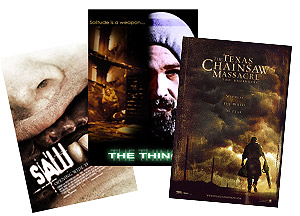Berkeleyan
Research subjects were asked to be afraid - very afraid
Marketing professor explores viewers' mixed responses to scary movies
![]()
| 17 October 2007
Eduardo Andrade wondered why his wife loves scary movies that make him squirm.
So the assistant professor of marketing at the Haas School of Business, interested in consumer behavior, teamed up with a colleague to deconstruct what happens when people watch horror films. The results of their research were reported in the October 2007 issue of the Journal of Consumer Research.
Andrade says these results have tremendous implications for improved understanding of consumer behavior in various realms. He's already heard from a movie-industry representative looking for promotional help during the Halloween season.
 Some people just love horror films; others, to put it mildly, don't. New research suggests that the latter can experience greater enjoyment if they view the action from within a 'protective frame' that helps them distance themselves from it. |
In their research, Andrade and his colleague, Joel Cohen, a professor of marketing and anthropology at the University of Florida, poked holes in the prevailing theories about why people sometimes seek out activities that provoke unpleasant feelings. One common theory has been that people benefit from unpleasant or painful situations by experiencing a flood of relief afterward; another routine explanation is that some people just don't experience fear at the same depths that other, more sensitive souls do.
"Those theories are based on the premise that people cannot experience mixed feelings," says Andrade. "What if this assumption is relaxed?" Mounting evidence suggests that negative and positive emotions can be "co-activated" at the same time, he maintains.
In a series of four studies, the researchers brought dozens of undergraduates - members of an age group that finds horror movies quite enjoyable - into Berkeley's Experimental Social Sciences Laboratory (XLab) to watch clips of the horror classics The Exorcist and Salem's Lot. To balance things out, the professors also showed the students snippets from documentary films and the TV comedy Friends.
Students were divided into two groups: fans of frightful flicks and those who tend to avoid them. One finding that surprised Andrade was that both groups reported, on a scale of zero to 100, similar levels of negative feelings while watching the clips. But the most remarkable finding was on the positive side. Whereas nonwatchers of horror movies reported low to flat levels of "negative affect" during the scary clips, fans of those flicks reported high levels of happiness. Moreover, the peak of their happy feelings occurred during the most frightening segments of the film clips.
The researchers also found, as anticipated, that it was only after a horrifying scene ended that the nonfans experienced higher levels of positive feelings, or a sense of relief. This effect was not pronounced among horror-movie fans who already had been deriving pleasure from the fearful scenes.
Proponents of the relief theory used to attribute the relief experienced at the end of a scary movie to the films' positive resolution, says Andrade. However, the villains in many contemporary scary movies tend to live on - if for no other reason than for the next sequel, he notes.
What stood out most for Andrade and Cohen were the students' almost simultaneous experiences of happiness and fear, and the discovery that the happiness of scary-movie nonfans increased when subjects saw introductory clips about a film's two primary actors - the good guy and the bad ghost - followed by movie clips bracketed on their computer screen by the actors' photos.
Andrade said that this "protective frame," which reminded viewers that the films were make-believe and helped them distance themselves from the fearful content on the screen, appeared to increase viewing enjoyment among the nonfans, letting them experience fear but also pleasant excitement. Fans of horror flicks seem to already have a protective frame of safety, distance, or detachment that lets them absorb fear and still enjoy themselves, he says.
From a practical perspective, Andrade says, further research could reveal protective-frame cues that marketers could apply to stimulate interest and sales. On a theoretical level, he adds, it would be interesting to obtain physiological measurements or brain scans from the viewers to better interpret the results.
Andrade claims that his research, which has increased his awareness of the concept of a protective frame, is helping him with his own scary-movie viewing experiences - up to a point. "I'm still not yet a horror-movie fan," he says, "but I can sit next to my wife on the couch for a longer time while she's watching one."
Readers with UC access privileges may read "On the Consumption of Negative Feelings" at www.journals.uchicago.edu/JCR; enter the search term "horror films."

